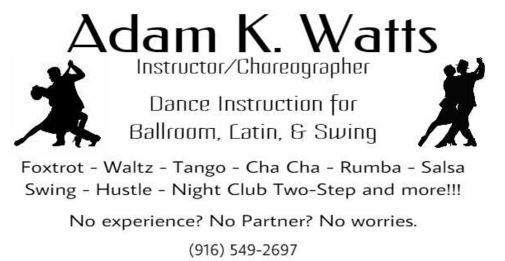|
The following tips address some concepts that are more likely to come into play for someone that has been dancing for a while. However, they are also good for the novice dancer to keep in mind.
The tips below are focused more on social dancers, rather than competitive dancers.
What is the key difference between a beginning dancer and an advanced dancer?
One popular misconception is that "beginning" means "new." This is not the case. There are typically three levels to any dance syllabus, regardless of which syllabus you are using. These are Bronze, Silver and Gold. In relation to this, a beginning dancer is a dancer who is at the Bronze level. By the time you complete Bronze and can execute all the moves well, you are an intermediate dancer. Then it is time to embark on the Silver level syllabus. Silver takes a dancer from intermediate to advanced. The Gold level is strictly advanced and not for the faint of heart.
Another way to gauge whether someone is a beginning or advanced level dancer:
- The beginning dancer just wants to learn more moves.
- The advanced dancer wants to improve on the basics.
Why is this? The advanced dancer would rather do 5 figures really well than 10 figures poorly. Of course everyone does want to learn more moves, but until a person transitions from focusing on learning more moves to being a better leader/follower, I would consider them a beginning dancer.
Of course, skill is also a factor. Skill is all about the basics. The more difficult/advanced the dance move, the higher level of fluency in the basics is needed. You can be a 30-year veteran dancer and still be a beginner. You can also dance for less than a year and be advanced.
What are �the basics�?
Generally speaking, this refers to the following:
- How to step.
- How to keep from getting off your axis (losing balance).
- How to keep from pushing/pulling your partner off of their axis.
- How to clearly lead your partner.
- How to understand and follow your partner.
- What are the characteristics, besides timing, that differentiates one dance from another?
- How to do all of the above and to look good while doing it.
All of these things are what make up the subject of �technique.� Unless you take a class that is specifically focused on technique (or private lessons) it is extremely unlikely that you can develop more than a superficial understanding of these things.
I can get my partner/myself through the figures, why should I bother with more technique?
The ease with which your partner gets through the move will increase if your technique improves. Typically, if something doesn�t go smoothly in lead/follow, a dancer will make one of two assumptions:
- It didn�t go well because my partner did not lead/follow well.
- It didn�t go well because I did not lead/follow well.
If your partner thinks it is their fault, this does not mean it is true. Likewise, if your partner thinks it is your fault, this does not make that true either. There is never really a finite end to improvement. If you are not aware of things you are doing that need improvement, no matter how good or advanced you are as a dancer, you're not paying attention.
When is it appropriate in social dancing or in a dance class to correct/teach my partner?
If you are not a dance instructor, the most likely answer to this question is never. There are exceptions to this in social dancing: If your partner asks, it is acceptable to answer. If it is clearly their first time dancing, you can assist them to learn the very basic moves, but do NOT try to show off by trying more advanced moves with them. (You can be confident and knowledgeable by referring them to a group class or private instructor.)
In a dance class, let the instructor know if your partner is having trouble; that is why they are there.
I am a leader and I like to improvise new moves. Is this okay?
Yes. Not only is this okay, but it is encouraged. However, it becomes even more important for you to hone your skills as a leader. If you are going to try leading your partner through a move you have invented, you are going to have a hard time if your lead is not crystal-clear. This is also a safety issue. Leading your partner in an unexpected step, turn or direction without sufficient skills and without sufficient understanding of the basics in relation to your partner can result in injury to joints or in pushing/pulling your partner off of their feet. Remember, you may be the leader but your partner is responsible for executing their steps. To do that they must have complete control of their balance, weight and footwork. You can guide and even assist; but never override or man-handle.
What is the best way to become a better leader?
One great way to improve your skills as a leader is to try following. Learn to follow some basic steps and turns. This will give you an understanding of the other side of the dynamic. It will help clarify when certain things should be led, and what foot your partner needs to be on to go where you want them to go. Until you have danced their steps, you will not really understand what they have to do. This will limit your ability to understand what you have to do. And of course, work on your basics.
What is the best way to become a better follower?
There are a number of things you can do to be a better follower and once again it comes back to the basics. A key factor in being a good follower aside from the basics is to never anticipate what the leader is going to do. In other words, don't try to "guess" what your partner wants you to do and where you should step; feel what your partner is doing through your connection. A fun thing to do for practice that will help you improve your following is to try dancing blind-folded. You can also try learning how to lead; by leading another dancer you will become more aware of the things that followers do or don't do that impact how well a leader can lead and then adjust your own following based on those observations.
I think I'd like to teach. What is the best way to begin?
The first thing to do if you are interested in teaching is to start learning the opposite part. If you are a leader, start learning to follow. If you are a follower, start learning to lead. Go to some beginning group classes and take the opposite role.
Second, work on your technique; always demonstrate a dance at a high level of skill. Your student may not be able to dance at that level, but you are providing them a goal through your example. If your technique is sloppy, they will think that's all they need to do and won't progress very far.
Check the studios in your area to see if any offer a teacher training program. There is certification available. However, you do not need a certification to teach. You need to be able to teach both leaders and followers and to demonstrate for both, you need to be proficient and professional, and you need to be able to clearly and effectively communicate with your students and connect with them.
|


